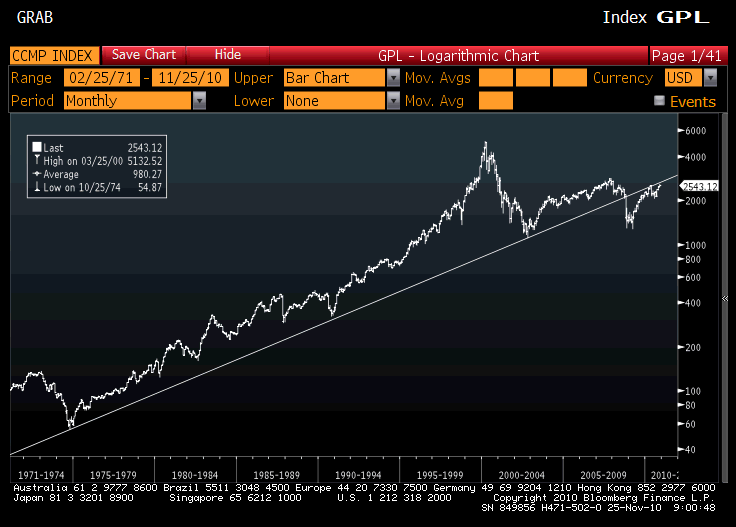Is this Nasdaq Chart Bullish?
This comes from Andy Lees of UBS:
A few weeks ago I sent out a note highlighting that the Nasdaq was approaching its post 1974 trend line from which the average movement has been 24.06% in the subsequent couple of months. At the time I said that whilst the chart theory would sell the rally, I would favour a breakthrough and suggested buying the S&P Jan 1250 calls @ 9.6
- 3rd Oct ’74 -> 8th Nov ’74 +21.6% from 54.87 to 66.75
- 12th Oct 90 -> 6th Dec ’90 +17.1% from 322.98 to 378.4 on its way to 481 by March the following year
- 10th Oct 02 -> 29th Nov 02 +37.7% from 1108.49 to 1526.4
- 26th Sep 08 -> 23rd Oct 08 -30.3% from 2155 to 1502
- 26th Apr 10 -> 6th May ’10 -13.6% from 2535 to 2189
The trend line comes in today at 2670.73, so just 10 points away.
The only time the trend has been broken was October 2008 when it subsequently fell 30.3%. There are major obstacles, but positioning is clearly taking account of that risk, and I think Europe will not prove to be the disaster that most people are assuming – (see today’s Bloomberg article re Odey’s view that the German private sector will be sufficiently strong to bailout peripheral Europe rather than needing government transfers). The chart I attached to the daily this morning showed the rapid liquidity growth now happening in the Japanese banking system, and hopefully US M3 growth should soon start turning positive. With the caution still overhanging the market I am thinking next year’s rally could all happen in Q1 before perhaps being de-railed by commodity price rises mid year. I would suggest lengthening the duration of the options and buying S&P March 1275 calls @ 26 (and given the risk of a large move around this chart level, perhaps selling futures exposure and replacing it with a delta neutral position may be worth considering).
I definitely have a more bullish tone of late. Longer-term, the still undercapitalized financial system is an impediment to growth in the developed world and will probably spell crisis down the line. The medium-term systemic issues are out there too. The major ones I can think of now are austerity and the sovereign debt crisis in Europe. In the US, there is the state and local government fiasco, potential federal government budget confrontations, and mortgage fraud issues. In the emerging markets, the only real risk at this point comes from excessive tightening. And Michael Pettis makes a good case that, as far as China goes, any slowdown won’t spill over outside China.
I don’t want to wave away these risk factors. They are real but the business cycle builds upon itself.
A lot of the economic cycle is self-reinforcing (the change in inventories is one example). So it is not completely out of the question that we see a multi-year economic boom. Higher asset prices, lower inventories, fewer writedowns all lead to higher lending capacity, higher cyclical output, more employment opportunities and greater business and consumer confidence. If employment turns up appreciably before these cyclical agents lose steam, you have the makings of a multi-year recovery. This is how every economic cycle develops. This one is no different in this regard.
So to those of you who say, fiscal and monetary stimulus don’t work, I say yes they do:
A soothsayer who counsels against this type of economic policy, but who warns of impending collapse will surely be seen as the boy who cries wolf. Think back to 2001 or 2002. Did we not witness then the same spectacle whereby the bears and doomsayers were let out of their holes to warn of impending doom from reckless economic policy? By 2004, unless these individuals changed their tune, they were long forgotten or even laughed at – only to resurface in 2007 and 2008 with their new tales of woe…
The fact is: low quality growth does not lead to immediate economic calamity. It can continue through many business cycles. Even today, it is wholly conceivable that we could experience a multi-year economic expansion on the back of renewed monetary and fiscal expansion…
You will recall that I wrote a post at the depths of the market implosion highlighting a phrase by Marc Faber, “Don’t underestimate the power of printing money.” This quote has stuck with me as asset markets have soared in the intervening time. What Faber was alluding to was the fact that printing money works. It does goose the economy as intended and it can induce a cyclical recovery.
But, let me throw the gloom and doomers a bone, since I agree with their secular view. What I would say is that to the degree growth is ‘poor quality’ growth geared toward sectors which suffer from overinvestment like autos, financial service or housing, the cyclical recovery will end prematurely with a boatload of debt and malinvestment and we will be right back where we started. Only this time the debt levels in the public sector will be far greater and interest rates will be less able to work their magic since they are already low. If we get through this period without structural reform, the next recession will be terminal debt, the end of the line.

I see the underlying economic data as more bullish of late and that is supportive of equities. That’s the near term (through say Q1). The question becomes what happens next. The muni thing is certainly something to watch as is the European debt crisis.